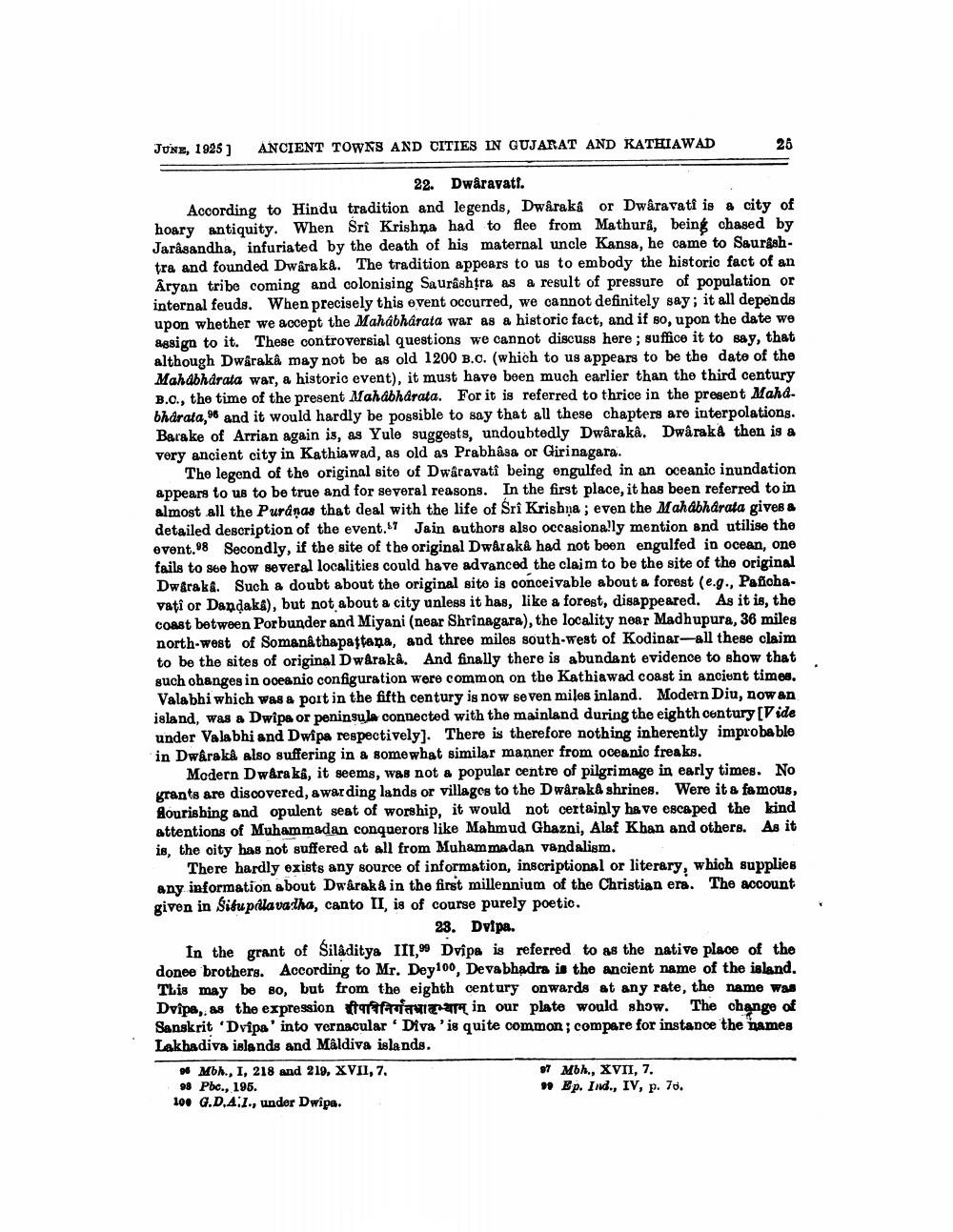________________
JUNE, 1925)
ANCIENT TOWNS AND CITIES IN GUJARAT AND KATHIAWAD
22. Dwaravatf. According to Hindu tradition and legends, Dwaraka or Dwaravati is a city of hoary antiquity. When Sri Krishna had to flee from Mathura, being chased by Jarasandha, infuriated by the death of his maternal uncle Kansa, he came to Saurashtra and founded Dwaraka. The tradition appears to us to embody the historic fact of an Aryan tribe coming and colonising Saurashtra as a result of pressure of population or internal feuds. When precisely this event occurred, we cannot definitely say; it all depends upon whether we accept the Mahabharata war as a historic fact, and if so, upon the date we assign to it. These controversial questions we cannot discuss here ; suffice it to say, that although Dwarakâ may not be as old 1200 B.C. (which to us appears to be the date of the Mahabharata war, a historic event), it must have been much earlier than the third century B.O., the time of the present Mahabharata. For it is referred to thrice in the present Maha. bharata, 98 and it would hardly be possible to say that all these chapters are interpolationg. Barake of Arrian again is, as Yule suggests, undoubtedly Dwaraka. Dwaraka then is a very ancient city in Kathiawad, as old as Prabhâsa or Girinagara.
The legend of the original site of Dwaravati being engulfed in an oceanic inundation appears to us to be true and for several reasons. In the first place, it has been referred to in almost all the Puranas that deal with the life of Sri Krishna, even the Mahabharata gives & detailed description of the event. Jain authors also occasionally mention and utilise the event.°8 Secondly, if the site of the original Dwaraka had not been engulfed in ocean, one fails to see how several localities could have advanced the claim to be the site of the original Dwaraka. Such & doubt about the original sito is conceivable about a forest (e.g., Pañoha. vati or Dandaka), but not about a city unless it has, like a forest, disappeared. As it is, the coast between Porbunder and Miyani (near Shrinagara), the locality near Madhupura, 36 miles north-west of Somanâ thapajtana, and three miles south-west of Kodinar-all these claim to be the sites of original Dwaraka. And finally there is abundant evidence to show that such ohanges in ooeanio configuration were common on the Kathiawad coast in ancient times. Valabhi which was a port in the fifth century is now seven miles inland. Modern Diu, now an island, was a Dwipe or peninsula connected with the mainland during the eighth century [Vide under Valabhi and Dwipa respectively). There is therefore nothing inherently improbable in Dwaraka also suffering in & somewhat similar manner from oceanic freaks.
Modern Dwaraka, it seems, was not a popular centre of pilgrimage in early times. No krants are discovered, awarding lands or villages to the Dwaraka shrines. Were it & famous, Aourishing and opulent seat of worship, it would not certainly have escaped the kind attentions of Muhammadan conquerors like Mahmud Ghazni, Alaf Khan and others. As it is, the city has not suffered at all from Muhammadan vandalism.
There hardly exists any source of information, inscriptional or literary, which supplies any information about Dwarak & in the first millennium of the Christian era. The account given in Sisupalava tha, canto II, is of course purely poetic.
28. Dvipa. In the grant of Silâditya 111,99 Dvipa is referred to as the native place of the donee brothers. According to Mr. Dey100, Devabhadra is the ancient name of the island. This may be 80, but from the eighth century onwards at any rate, the name was Dvipa, as the expression frafratar in our plate would show. The change of Sanskrit Dvipa' into vernacular Diva 'is quite common; compare for instance the names Lakhadiva islands and Maldiva islands. Mbh., I, 218 and 219, XVII, 7.
97 Mh., XVII, 7. 98 Pbc., 195.
" Ep. Ind., IV, p. 7o. 10. G.D.A:1., under Dwipa.




